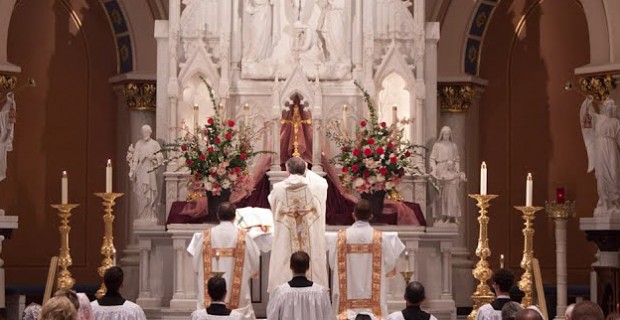by George Neumayr

Liberal bishops dismissed Summorum Pontificum, Pope Benedict XVI’s apostolic constitution authorizing wider use of the traditional Latin mass, as a bone thrown to over-the-hill conservatives. But Pope Benedict XVI probably wrote it more for the young than the old.
One of the points he stressed in his letter accompanying Summorum Pontificum was that “what earlier generations held as sacred remains sacred for us too.” He had previously written that the widespread contempt for the old mass—the treatment of it as something “forbidden”—constituted an act of self-mutilation for a religion predicated on tradition.
Among the groups interested in the traditional Latin mass were youth, he noted: “young persons too have discovered this liturgical form, felt its attraction, and found in it a form of encounter with the Mystery of the Most Holy Sacrifice particularly suited to them.”
Left-wing Catholic publications, normally so attentive to the enthusiasms of youth, have taken no interest in this phenomenon. To the extent that they acknowledge it all, they adopt a tone of mocking. A few years back, after thousands of young people flocked to a Pontifical Solemn High Mass held in D.C.’s Basilica of the National Shrine of the Immaculate Conception, US Catholicgasped, “Really? Seriously?” It treated the event as a joke.
The secular press covers youth interest in the traditional Latin mass far more respectfully. TheEconomist recently reported on the “traditionalist avant-garde.” The old mass, it found, isn’t petering out but picking up some speed: “The Latin Mass Society of England and Wales, started in 1965, now has over 5,000 members. The weekly number of Latin masses is up from 26 in 2007 to 157 now. In America it is up from 60 in 1991 to 420. At Brompton Oratory, a hotspot of London traditionalism, 440 flock to the main Sunday Latin mass. That is twice the figure for the main English one.”
The influx of conservative Anglicans has bolstered these numbers a bit: “Dozens of Anglican priests have ‘crossed the Tiber’ from the heavily ritualistic ‘smells and bells’ high-church wing; they find a ready welcome among traditionalist Roman Catholics.”
But the principal source of growth comes from youth interest. “Like evangelical Christianity, traditional Catholicism is attracting people who were not even born when the Second Vatican Council tried to rejuvenate the church,” says The Economist. “Traditionalist groups have members in 34 countries, including Hong Kong, South Africa and Belarus. Juventutem, a movement for young Catholics who like the old ways, boasts scores of activists in a dozen countries.”
Self-consciously “relevant” Catholicism is increasingly seen by the young as irrelevant. Youth masses that try to imitate the trends of the world, often lamely, generate only sporadic attendance. Substanceless liturgies leave them bored, and they apparently deduce from the relativistic theology on display at them that the logical terminus of liberal Catholicism is to lapse.
In John Zmirak’s engaging new book, The Bad Catholic’s Guide To the Catechism, he explains the paradoxical appeal of the old mass to the young. At first, he says “he hated it,” but something about it kept him interested: “some sense that you’re peering through a window out of time, seeing through a glass not quite so darkly into another world far realer than our own.”
“You’ll feel a little alienated, maybe even offended,” he writes to the skeptical. “Who is this guy in the shiny robe to turn his back on me and talk to the crucifix instead? You’ll resent the calisthenics, the hopping up and down then falling back on your knees, and you’ll likely find the prayers archaic and strange, like a quote from the Magna Carta….Any traditional rite will be thoroughly off-putting, just like cardio, mathematics, or parenthood. But if you stick with it, you’ll learn to ‘see’ something profound and true: a sacrificial ritual enacting a solemn marriage between the fallen muck of earth and fire falling from heaven.”
The liberal architects of the post-Vatican II period find the traditionalist revival baffling. The Economist quotes liberal Dominican Timothy Radcliffe to the effect that new interest in the old mass is just a form of empty nostalgia. But the explanation is no more complicated than what Jesus Christ told his disciples: the young desire bread, not stones.
This column first appeared January 3, 2013 in RealClearReligion.org and is reprinted with permission.
Tagged as: Brompton Oratory, John Zmirak, Pope Benedict XVI, Summorum Pontificum, Traditional Latin Mass
The views expressed by the authors and editorial staff are not necessarily the views of
Sophia Institute, Holy Spirit College, or the Thomas More College of Liberal Arts.
By George Neumayr
George Neumayr, a contributing editor to The American Spectator, is co-author (with Phyllis Schlafly) of No Higher Power: Obama's War on Religious Freedom.
No comments:
Post a Comment